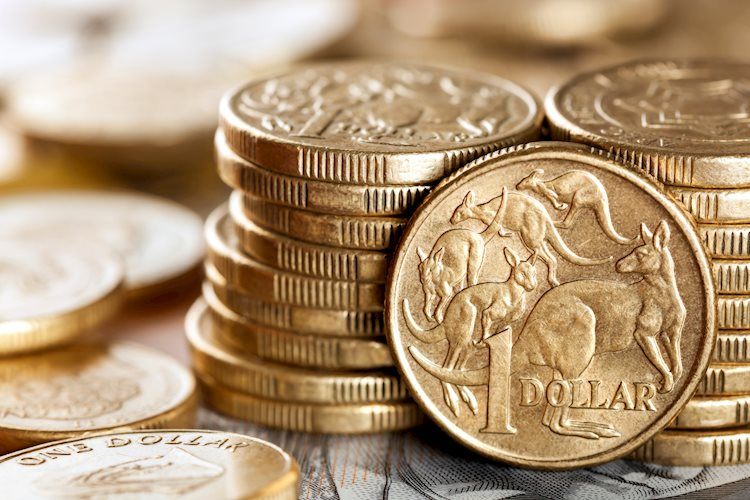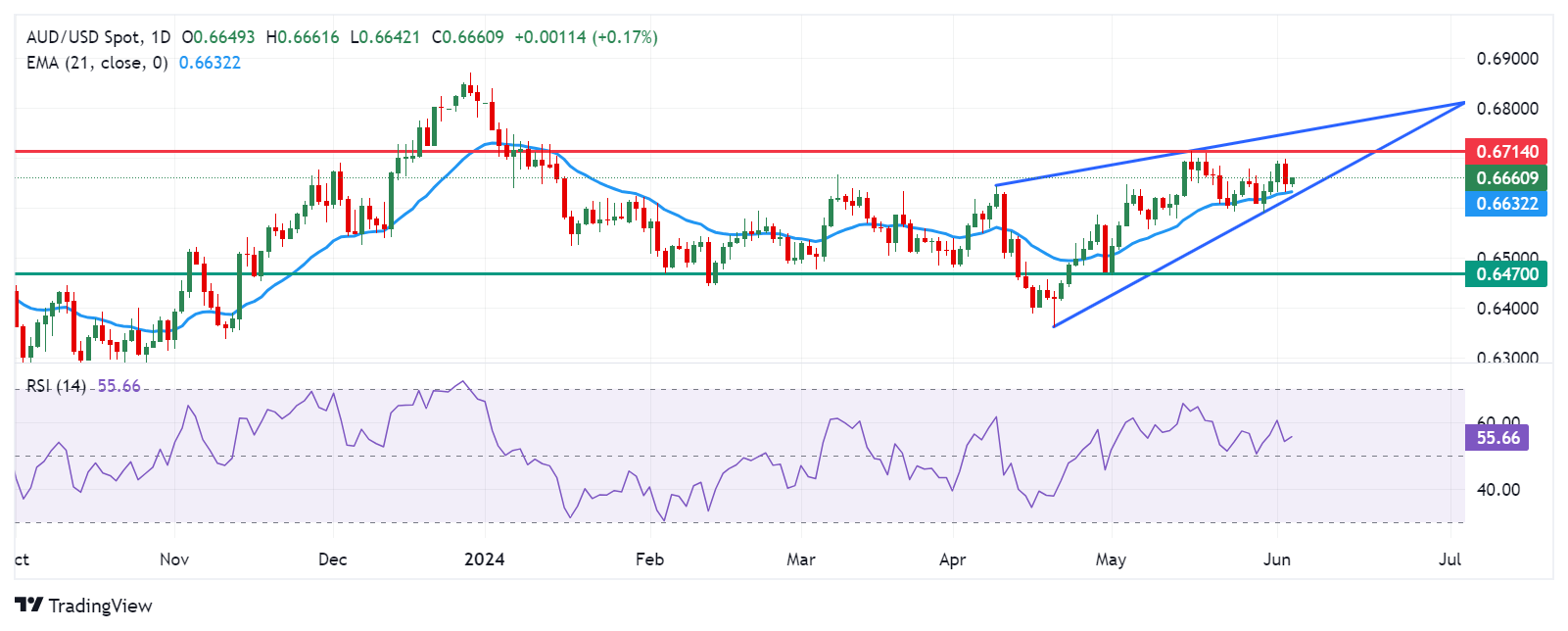- The Australian Dollar appreciates after the release of the lower-than-expected GDP data on Wednesday.
- Australia’s GDP grew 0.1% QoQ in the first quarter, falling short of the expected 0.2% reading.
- The US Dollar could rebound due to the higher US Treasury yields.
The Australian Dollar (AUD) gains ground, possibly due to improved risk sentiment on Wednesday. The upside of the Aussie Dollar could be limited due to the lower-than-expected Gross Domestic Product data, which grew 0.1% QoQ in the first quarter, against the expected 0.2% reading. On an annual basis, the economy grew 1.1%, slightly below the expected 1.2%. The AUD/USD pair received pressure as the Judo Bank Purchasing Managers Index (PMI) came in at 52.5, lower than the expected reading of 53.1 for May.
The Reserve Bank of Australia (RBA) Governor Michele Bullock stated on Wednesday that she anticipates GDP growth for the first quarter to be quite low. Bullock also emphasized that the central bank is prepared to take action if the Consumer Price Index (CPI) does not return to the target range, as reported by NCA NewsWire.
The US Dollar (USD) could rebound due to the upward correction in US Treasury yields. The USD weakened on the back of rising speculation of an interest rate cut by the Federal Reserve (Fed) this year. Investors await the key US data releases later on Wednesday, including the US ADP Employment Change and ISM Services PMI reports.
Daily Digest Market Movers: Australian Dollar appreciates despite softer economic growth
- The Judo Bank Composite PMI recorded a reading of 52.1 in May, a slight decrease from 53.0 in April. This shows that Australia’s private sector output continued to grow for the fourth consecutive month, though at a slower rate.
- Caixin China Services PMI came in at 54 in May, exceeding the expected 52.6 and 52.5 prior.
- Australia reported on Tuesday, a current account deficit of A$4.9 billion (USD 3.2 billion) in the first quarter, marking a significant shift from a downwardly revised surplus of A$2.7 billion in the previous quarter. This result missed market expectations, which had anticipated a surplus of A$5.9 billion.
- The ISM Manufacturing PMI unexpectedly dropped to 48.7 in May, down from April’s reading of 49.2 and below the forecast of 49.6. The US manufacturing sector experienced its second consecutive month of contraction, marking 18th in the last 19 months.
- Australia’s Judo Bank Manufacturing PMI was released on Monday, edging up slightly to 49.7 in May from 49.6 in April, marking the fourth consecutive month of declining conditions in the manufacturing sector.
- On Monday, the Caixin China Manufacturing PMI rose to 51.7 in May from 51.4 in April, marking the seventh consecutive month of expansion in factory activity and surpassing the estimates of 51.5. Friday’s NBS PMI data showed that manufacturing activity fell to 49.5 in May from 50.4 in April, missing the market consensus of an increase to 50.5. Meanwhile, the Non-Manufacturing PMI declined to 51.1 from the previous reading of 51.2, falling short of the estimated 51.5.
- Last week, Atlanta Fed President Raphael Bostic remarked in an interview with Fox Business that he doesn’t believe further rate hikes should be required to reach the Fed’s 2% annual inflation target. Additionally, New York Fed President John Williams stated that inflation is still too high but should moderate over the second half of 2024. Williams doesn’t feel the urgency to act on monetary policy, per Reuters.
Technical Analysis: Australian Dollar hovers around 0.6650
The Australian Dollar trades around 0.6650 on Wednesday. A daily chart analysis indicates a bullish bias for the AUD/USD pair, as it remains within a rising wedge pattern. Additionally, the 14-day Relative Strength Index (RSI) is slightly above the 50 level, reinforcing this bullish bias.
The AUD/USD pair could potentially target the psychological level of 0.6700, followed by the four-month high of 0.6714 and the upper limit of the rising wedge around 0.6750.
On the downside, immediate support is seen at the 21-day Exponential Moving Average (EMA) at 0.6632, followed by the lower boundary of the rising wedge and the psychological level of 0.6600. A further decline could exert pressure on the AUD/USD pair, potentially pushing it toward the throwback support region at 0.6470.
AUD/USD: Daily Chart
Australian Dollar price today
The table below shows the percentage change of the Australian Dollar (AUD) against listed major currencies today. The Australian Dollar was the strongest against the Japanese Yen.
| USD | EUR | GBP | CAD | AUD | JPY | NZD | CHF | |
| USD | -0.03% | -0.04% | -0.05% | -0.23% | 0.13% | -0.22% | 0.03% | |
| EUR | 0.03% | -0.01% | -0.02% | -0.18% | 0.19% | -0.16% | 0.07% | |
| GBP | 0.05% | 0.01% | -0.01% | -0.17% | 0.20% | -0.15% | 0.08% | |
| CAD | 0.05% | 0.01% | 0.00% | -0.18% | 0.23% | -0.16% | 0.10% | |
| AUD | 0.23% | 0.19% | 0.17% | 0.18% | 0.38% | 0.01% | 0.27% | |
| JPY | -0.12% | -0.20% | -0.20% | -0.19% | -0.35% | -0.37% | -0.12% | |
| NZD | 0.22% | 0.18% | 0.17% | 0.17% | -0.01% | 0.34% | 0.24% | |
| CHF | -0.03% | -0.07% | -0.08% | -0.08% | -0.25% | 0.13% | -0.23% |
The heat map shows percentage changes of major currencies against each other. The base currency is picked from the left column, while the quote currency is picked from the top row. For example, if you pick the Euro from the left column and move along the horizontal line to the Japanese Yen, the percentage change displayed in the box will represent EUR (base)/JPY (quote).
Australian Dollar FAQs
One of the most significant factors for the Australian Dollar (AUD) is the level of interest rates set by the Reserve Bank of Australia (RBA). Because Australia is a resource-rich country another key driver is the price of its biggest export, Iron Ore. The health of the Chinese economy, its largest trading partner, is a factor, as well as inflation in Australia, its growth rate and Trade Balance. Market sentiment – whether investors are taking on more risky assets (risk-on) or seeking safe-havens (risk-off) – is also a factor, with risk-on positive for AUD.
The Reserve Bank of Australia (RBA) influences the Australian Dollar (AUD) by setting the level of interest rates that Australian banks can lend to each other. This influences the level of interest rates in the economy as a whole. The main goal of the RBA is to maintain a stable inflation rate of 2-3% by adjusting interest rates up or down. Relatively high interest rates compared to other major central banks support the AUD, and the opposite for relatively low. The RBA can also use quantitative easing and tightening to influence credit conditions, with the former AUD-negative and the latter AUD-positive.
China is Australia’s largest trading partner so the health of the Chinese economy is a major influence on the value of the Australian Dollar (AUD). When the Chinese economy is doing well it purchases more raw materials, goods and services from Australia, lifting demand for the AUD, and pushing up its value. The opposite is the case when the Chinese economy is not growing as fast as expected. Positive or negative surprises in Chinese growth data, therefore, often have a direct impact on the Australian Dollar and its pairs.
Iron Ore is Australia’s largest export, accounting for $118 billion a year according to data from 2021, with China as its primary destination. The price of Iron Ore, therefore, can be a driver of the Australian Dollar. Generally, if the price of Iron Ore rises, AUD also goes up, as aggregate demand for the currency increases. The opposite is the case if the price of Iron Ore falls. Higher Iron Ore prices also tend to result in a greater likelihood of a positive Trade Balance for Australia, which is also positive of the AUD.
The Trade Balance, which is the difference between what a country earns from its exports versus what it pays for its imports, is another factor that can influence the value of the Australian Dollar. If Australia produces highly sought after exports, then its currency will gain in value purely from the surplus demand created from foreign buyers seeking to purchase its exports versus what it spends to purchase imports. Therefore, a positive net Trade Balance strengthens the AUD, with the opposite effect if the Trade Balance is negative.

